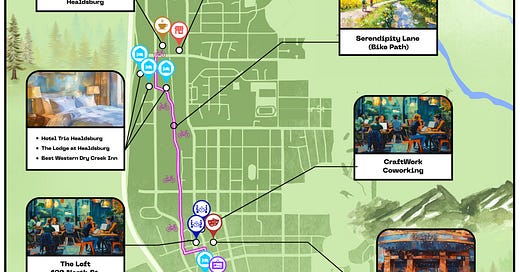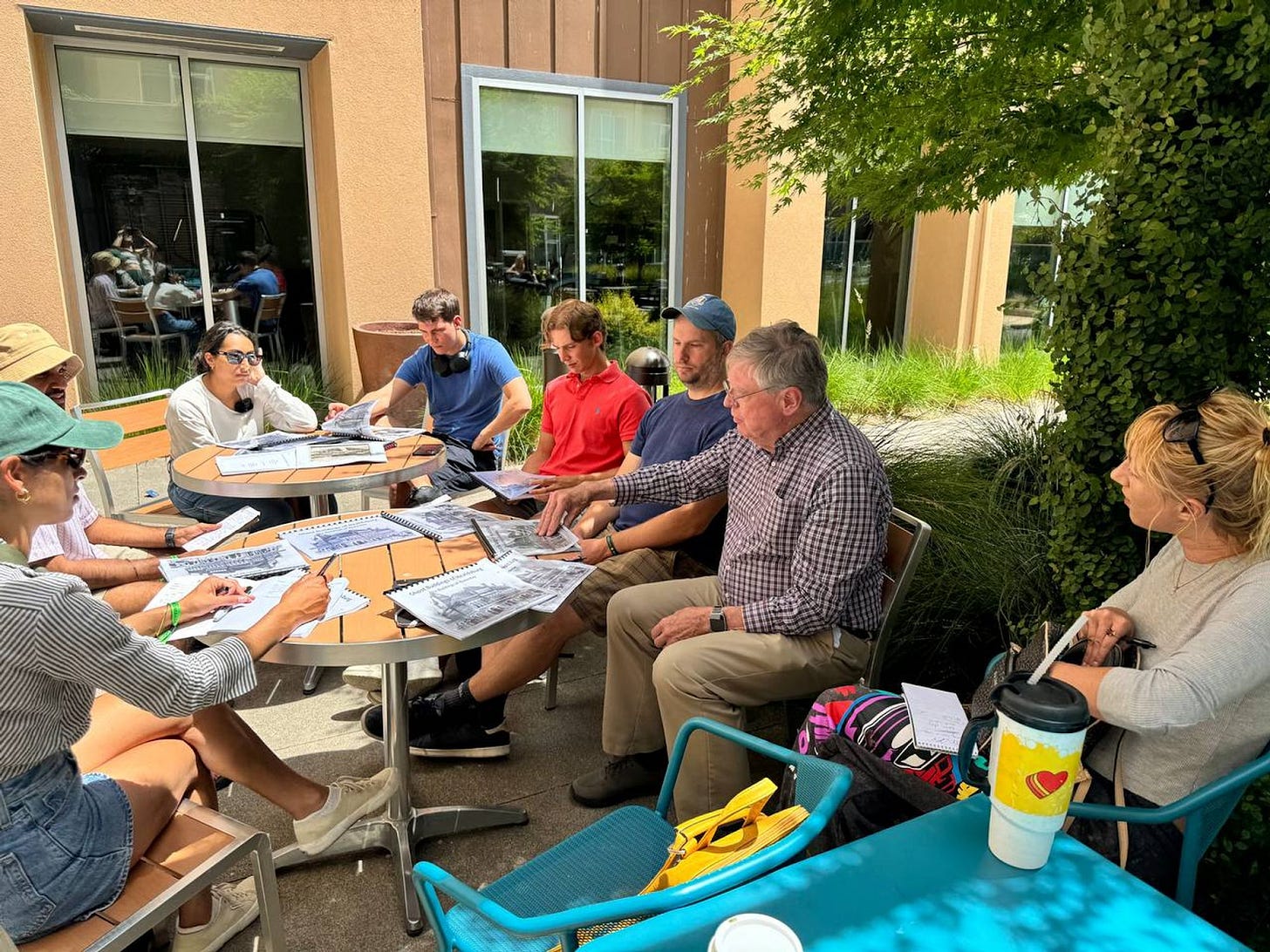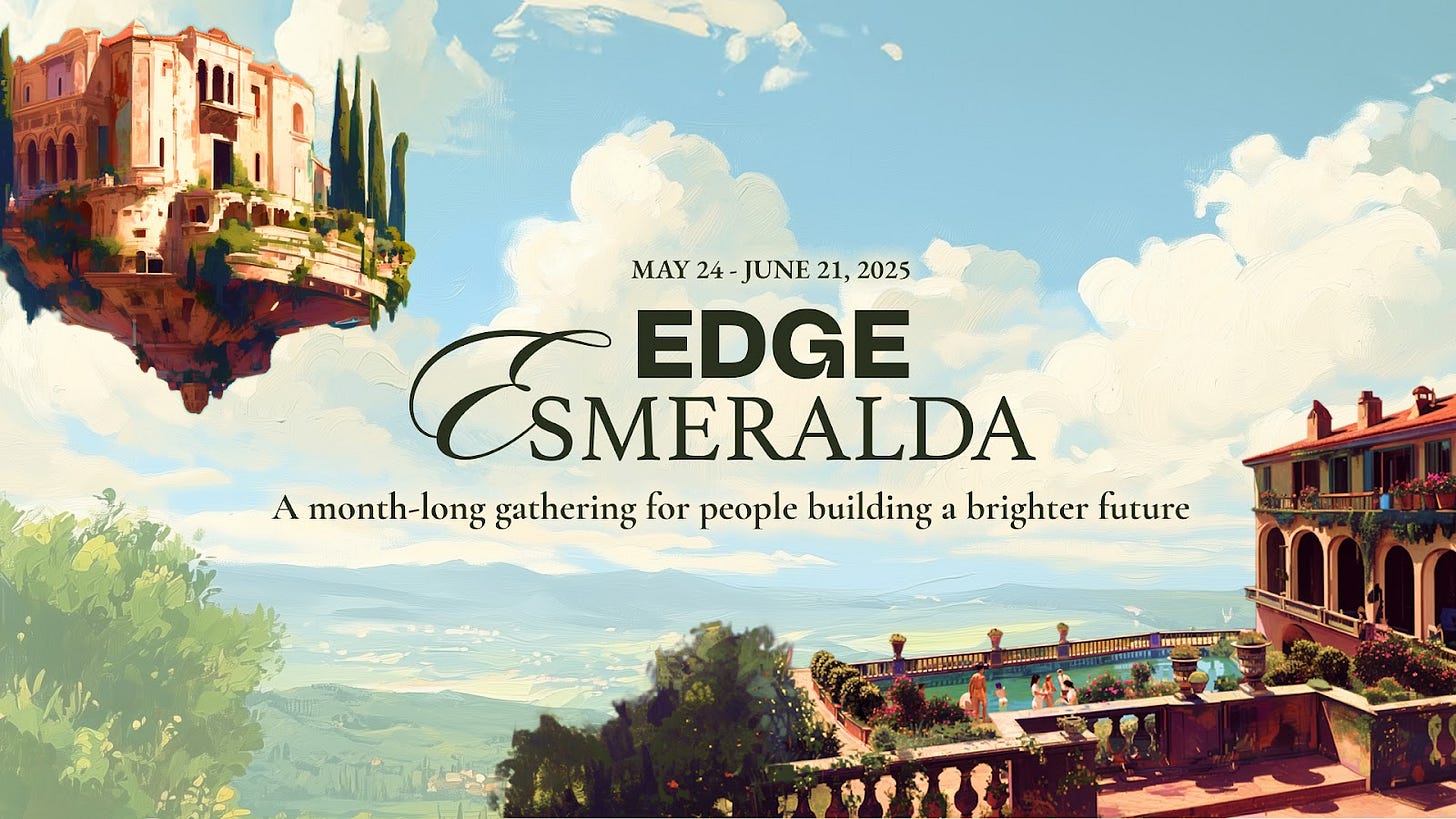Case Study: Edge Esmeralda
A month-long popup village for 1,300 people in Healdsburg, California
Note from Phil/Gillian:
This is a guest post from Timour Kosters, one of the co-founders of Edge City. Timour and the Edge City team partnered with a new town project called Esmeralda to create a temporary ‘popup village’ in the heart of Sonoma County called Edge Esmeralda in June 2024.
Both of us attended last year and found it to be a bold and inspiring experiment. The experience of seeing a fully functioning village spring to life within an existing town was eye-opening. We’re excited to see even more people explore and experiment with the idea of pop-up villages elsewhere.
Edge Esmeralda will happen again later this spring (May 24 - June 21) in Healdsburg California. We are excited to offer a discount code to the Supernuclear community. You can book directly here (skip the application) and use code SUPERNUCLEAR30 for 30% off tickets.
Name: Edge Esmeralda
Dates: June 2024 (and coming up again in 2025)
Location: Healdsburg, California (about 1.5 hours north of San Francisco)
Residents: ~1,300 (including ~80 children)
Governance: Core team coordinates infrastructure, local logistics, and main event structure. Participants self-organize most programming, activities, and side events.
Operating Model: Event tickets and partnerships cover costs. Local community engagement is integral.
Last June, we created a ‘popup village’ called Edge Esmeralda as an experiment in how people can come together to live, work, and collaborate differently. Over the course of a month, we had 1,300 people come through the experimental village (of which ~200 stayed the full time), in the town of Healdsburg, CA.
You can think of the experience as a cross between a college campus and a multigenerational community, but with a bend towards co-creation and building things—software, hardware, communities, startups, a family, physical infra, a research project, a new institute, or whatever you’d like to create.
Some people came to make progress on big, ambitious projects, while others were in the early stages of starting something new. We saw everything from neurotech demos and urbanist toolkits to team retreats and governance experiments take shape. The structure of the village created opportunities for people to connect and start collaborating in ways that rarely happen in everyday life.
Edge Esmeralda is a collaboration between my organization, Edge City, and Esmeralda (hence Edge Esmeralda!), a new town project by Devon Zuegel that is being built 15 minutes away from where we held the event.
How did we gather 1,300 people in Healdsburg?
We started by clearly communicating the vision: Edge Esmeralda would be an experimental popup village designed for people excited about building, learning, and collaborating in new ways. We initially reached out through existing networks—past Edge City attendees, followers of Devon's Esmeralda project, and groups already interested in innovative forms of community and urban living. Given Healdsburg’s proximity to SF, many people came up from the Bay Area. A lot of folks planned on coming up for a few days and ended up staying for several weeks once they experienced the community firsthand.
The concept resonated and spread organically, largely through word-of-mouth. Participants joined for various reasons: curiosity about new towns & frontier tech, interest in meaningful connections, or simply the opportunity to immerse themselves in a productive, healthy environment.
Where did everyone stay, and what were the community boundaries?
Participants stayed all across Healdsburg, distributed between local hotels (with a primary hub at Hotel Trio), Airbnbs, and rental homes. Because accommodations were integrated throughout town rather than concentrated in a single location, the popup village naturally became part of the broader community fabric, encouraging frequent and spontaneous interactions between attendees and locals.
For coworking and collaboration, we primarily used two main spaces: CraftWork and The Loft, the latter of which we fully took over as a dedicated coworking hub. Programming—like talks, workshops, and salons—occurred in various local venues throughout Healdsburg. Additionally, we partnered with local gyms, restaurants, and outdoor spaces, expanding the village experience across the entire town. While these locations provided practical gathering points, the village itself felt fluid, blending seamlessly into the local environment.
The participant experience
The day-to-day experience at Edge Esmeralda was different for everyone, but here’s an average day-in-the-life.
Mornings began with time in nature or a group workout class, followed by a session in the sauna/cold plunge. We had a morning running club and yoga classes, which became popular touchpoints for residents to connect.
During the day, people would spend time at the coworking space, cafés, and the plaza (a central square in Healdsburg). Folks worked independently or collaboratively, diving deep into projects ranging from biotech startups and experimental research to art installations and governance prototypes. Afternoons often had some programming, ranging from spontaneously organized workshops to talks on a variety of frontier topics.
In the evenings, we shared dinners with locally sourced ingredients and held salons to explore things like "Governance Games" and "Cities of Tomorrow.” Each weekend featured unconferences, like Eli Dourado and Ben Reinhardt's Hard Tech Weekend, where attendees explored breakthroughs in robotics, aerospace, and renewable energy.
As the month progressed, we settled into a natural rhythm, striking a balance between productivity and play and providing residents the freedom to define their own experiences.
Insights from Edge Esmeralda 2024
We approached everything with the mindset of emergence, meaning we created the container and intentionally left space for the community to shape the village themselves.
So, what did we learn? Here are some insights from the experiment.
Emergent programming over structured agendas
Rather than imposing a rigid schedule, we trusted participants to come up with the majority of the programming, which initially felt a bit risky but was ultimately extremely rewarding. It was essentially a monthlong series of unconferences.
People held workshops that we would never have thought to organize ourselves, like a session on developing nervous system mastery or a day-long workshop on acousto-optic imaging for neurotech.
Over 93% of sessions were organized by the community on our open shared calendar. I noticed that people reported enjoying the event much more when they helped to organize a session or generally got involved in co-creation, which makes sense. When people feel like they’ve contributed, they feel more connected to what is happening, and it creates a feeling of deeper engagement and authentic community-building.
Something I loved was that after someone gave a session, they would still usually be around for a few days (often a few weeks), meaning they would have a chance to host impromptu follow-up sessions to go deeper on the topic with people they inspired. I was pulled into a workshop on creating community spaces by Gillian, which is where I had a chance to go deep with Phil. Those conversations led to us being in touch and me writing this essay!
The length of the experience changes the interactions people have and how they show up
Readers of Supernuclear will know this, but the container that people are in shapes how they act and even what sides of their personalities express themselves most. This has never been clearer than at a popup village. Our container gives people extended time together, as compared to a normal conference, so we don’t get so much of the frantic ‘let’s connect’ energy that is more present at shorter gatherings. If you meet someone great, you know you’ll see them at breakfast or dinner the next day.
I’ve written before about how part of the magic of these popup villages is that they allow people to engage in a huge variety of different experiences with others in a relatively short timespan, which is a shortcut to meaningful connection. You might meet someone new and over the course of a week share experiences as varied as sauna & cold plunge, a hike, a coworking session, collaborating on a hackathon project, and having group dinners. By the end of the week, you’ll feel like you’ve known that person for months.
Also (again, obvious to Supernuclear folks), community-wide touchpoint moments are key. We had a shared dinner where everyone gathered every night of the week, which served as a daily heartbeat of the community. We held them at different restaurants throughout town, which also gave people a better sense of the environment.
Every Sunday, we had a big community dinner at a special venue. These were critical. For many people, the Sunday event served as the beginning or end of their experience at Edge Esmeralda, so it was a way to land into the week or wrap up your time there.
Being healthy is contagious
Everyone wants to be healthier, but it’s hard to do that in our default lives. We wanted to create a space where it’s just simple to be healthy. Ideally, it’s not something you have to even think about. Community meals focused on nutritious, locally-sourced foods (this involved quite a bit of work in convincing restaurants to do things slightly differently, like not use seed oils); impromptu fitness groups formed organically; and the whole thing was deliberately designed to encourage outdoor activity.
The cool thing about health activities is that they don’t only keep people healthy and energized—they’re also more surface area for people to connect in different ways that are different from just hanging out or connecting intellectually. That feeling of connection also enables greater wellbeing. People who initially joined Edge Esmeralda for intellectual stimulation left feeling physically healthier, proving our thesis that subtle shifts in environment can meaningfully impact community wellbeing.
People naturally build when given space and trust
We wanted to create an environment where people were in the mindset of actively building rather than passively consuming content (like most conferences). It didn’t take much convincing. Nick Foley and Anson Yu built a solar-powered A-frame pavilion in nearby woods, transforming it into a communal gathering spot. Other attendees started collaborative research projects, prototyped governance experiments, or used the time to start new companies and artistic endeavors.
These acts of building reinforced the culture, and as people arrived throughout the month, they also naturally started to invest energy into creating something meaningful. This is another good learning — the way the container evolves over the month is often path-dependent on the initial values that get imbued and how the month began. A lot of the vibe gets set beforehand in the pre-event comms and then especially with the people who show up in week 1.
Having kids around shifted the culture for the better
Initially, we knew we wanted to integrate multiple generations, but we weren't sure how it would play out. It turned out to be one of the best parts of the gathering. The attendees ranged from 6 weeks old to 86 years old. Children brought optimism and curiosity that permeated throughout the entire community. Elders shared learnings and expertise.
When kids are playing at every community dinner or in the parks, it creates a natural playfulness that makes it easier to break down social barriers and have spontaneous interactions. Seeing adults learn and play alongside kids added unexpected depth, making the experience feel warmer and more balanced.
In my experience, it’s rare to be in environments that are truly multi-generational, and it’s something we want to double down on. It genuinely improves the vibe, even for people without children or their parents/grandparents there. Age diversity naturally fosters empathy, patience, and openness—qualities critical for community building. It created a more welcoming and grounded culture than I’ve experienced in adult-only spaces.
Local integration is essential
Integrating with the local community was a top priority for us, and we were amazed by how deeply intertwined those relationships became to the actual event. Locals generously offered walking history tours, art classes at community studios, and practical knowledge about Sonoma County's culture and environment.
Another highlight was having the City Managers of Healdsburg and Cloverdale come to do a talk. Hearing firsthand about the realities of running a town—from day-to-day management to long-term planning—was incredibly eye-opening. It's pretty rare to get candid insights from the people who actually keep a city functioning smoothly.
These interactions transformed Edge Esmeralda from an event into something woven directly into the fabric of the town, forming genuine friendships that I’m excited to pick up again during Edge Esmeralda 2025.
Areas for improvement
We learned plenty, and there’s always room to grow:
Smoother onboarding, especially later in the month
This was a big one! We focused a lot on the initial experience of the people who arrived in the first couple of weeks, but as the month progressed, we had other things going on, and it was hard to find time to prioritize that for new arrivals. I felt that when people arrived on week 4, they were excited to be there, but felt like the vibe had already been set and weren’t sure how to enter it.
This coming year, we’ll focus more on that. Clearer onboarding, structured orientations, and stronger peer mentorship programs could help new arrivals integrate more quickly, creating a smoother experience for everyone. We’re going to experiment with a system where community members collaborate with our team to onboard the next cohort of people that arrive each week.
Figuring out what ideal active participation should look like
There is a tension here: we really want people to get involved and share their expertise or run a session. That’s what keeps the calendar alive and dynamic. At the same time, if everyone does a session, then the calendar can get overwhelming, and people can feel like there’s too much going on.
We’re excited to have people get involved in other ways, such as making the programming generally more participatory and taking on informal roles that add meaning without necessarily scheduling more events. For example, participants could help facilitate small-group discussions or mentor others in their areas of expertise. We also experimented with putting people together for decentralized dinners at Edge City Lanna (another popup village that we did in Thailand in Nov 2024), and we’ll likely run something like that again this year at Edge Esmeralda.
The goal is to spread participation beyond formal programming, creating more avenues for involvement that don’t overload the schedule.
Final thoughts and looking forward
I’m really enjoying this popup village format. It gives a lot of surface area to learn about what works well in a potential permanent environment and allows you to try things out before committing to something long-term. That’s why these temporary villages are such a good fit for permanent new town projects.
At the individual level, that might mean trying a new habit for the weeks that you’re there. At the community level, you can see what works best and adjust accordingly: is it better to prioritize shared breakfast or shared dinner, for example? (In our experience, it depends on the timezone. If you’re in PST, a shared dinner seems to work best since people like to have their mornings to work and make calls.)
If you’re considering living with friends (which you totally should!), maybe bring them to a popup village first and see how y’all get along in that environment before tying the knot. And if you want to do that…
This year, we’re going to run it back! Edge Esmeralda 2025 will take place May 24 - June 21st. We’re excited to implement what we learned above and try some new things as well. For example, we’re going to introduce the idea of residencies: smaller, themed sub-communities of about 10-20 participants within the larger popup village.
We warmly extend an invitation to everyone in the Supernuclear community to join us. You can see more info on the website, book directly here (skip the application) and use code SUPERNUCLEAR30 for 30% off tickets.
- Timour
—
Thanks Timour for sharing the story of Edge Esmeralda! Suggested further reading:













Thanks @Timour! Hoping to make it out again this year.
Can't wait!